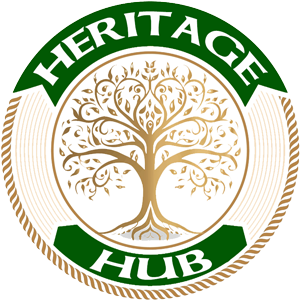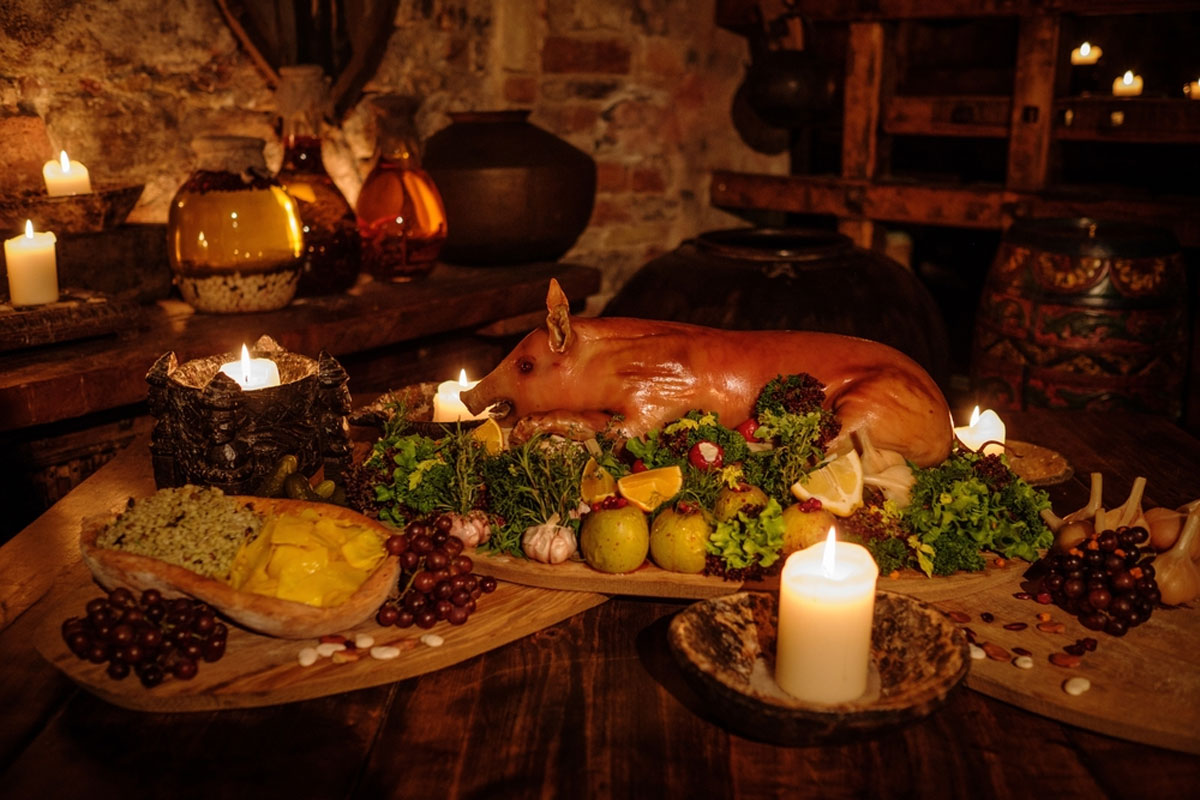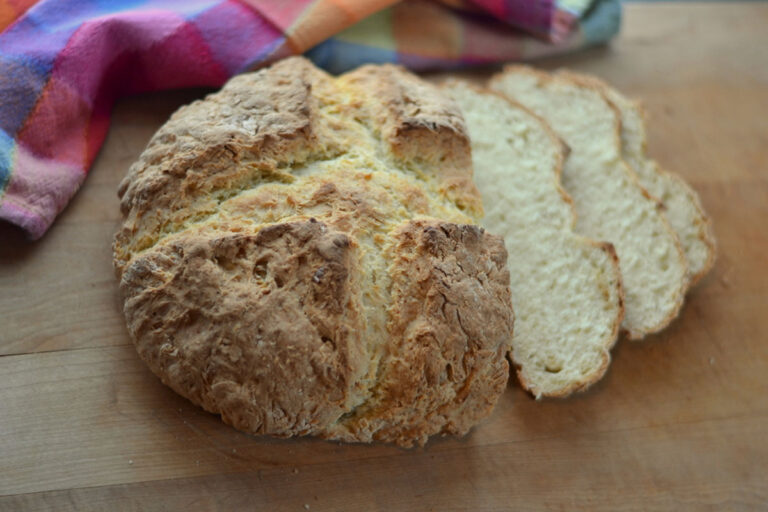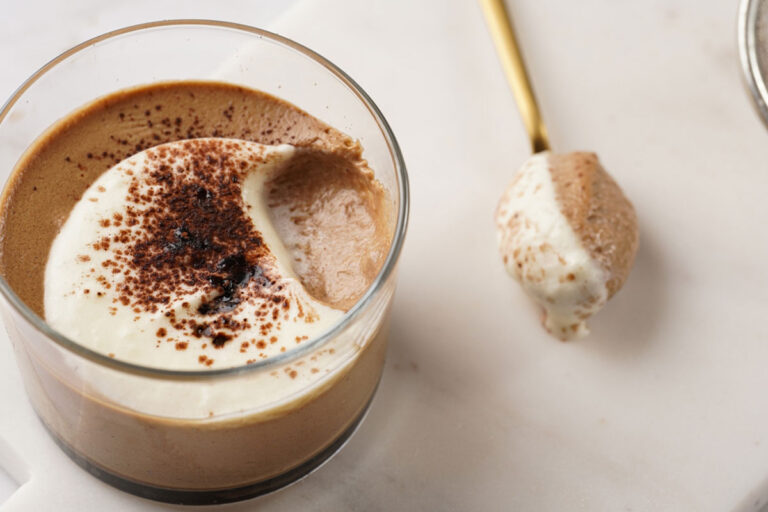The Monastic Influence on Medieval Irish Cuisine
In the medieval period, Irish monasteries were not only centers of spiritual life but also hubs of education, culture, and culinary innovation. The monks played a crucial role in preserving and developing culinary traditions that have shaped Irish cuisine to this day. Their contributions went beyond mere survival, as they cultivated, recorded, and enhanced the culinary practices of their time.
Agricultural Practices and Food Production
Monasteries in medieval Ireland were self-sufficient communities with extensive agricultural operations. The monks engaged in farming, gardening, and animal husbandry, which provided a steady supply of fresh produce, grains, and livestock. These agricultural activities were meticulously documented, ensuring the preservation of valuable knowledge and techniques.
- Crop Cultivation: Monasteries were known for their advanced crop rotation methods, which improved soil fertility and increased yields. They grew a variety of grains such as barley, oats, and wheat, which were essential staples in medieval diets. The monks also cultivated vegetables and herbs, including cabbage, leeks, onions, and parsley, which added diversity and nutrition to their meals.
- Livestock Management: The rearing of cattle, sheep, pigs, and poultry was integral to monastic life. The monks developed efficient breeding practices and animal care techniques, which ensured a steady supply of meat, dairy products, and eggs. The production of cheese, butter, and other dairy goods was a significant aspect of monastic cuisine.
- Horticulture and Orchards: Monasteries often had well-tended orchards and gardens, where they grew apples, pears, and other fruits. These fruits were used in cooking, baking, and the preparation of preserves and beverages. The cultivation of medicinal herbs was also common, reflecting the monks’ knowledge of herbal medicine and its application in both healing and culinary practices.
The Monastic Influence on Cooking Techniques and Recipes
The culinary skills of the monks were not limited to food production; they were also adept at cooking and baking. The kitchens of Irish monasteries were bustling centers where traditional recipes were refined, and new dishes were created.
- Bread and Baking: Bread was a fundamental part of the monastic diet, and the monks were skilled bakers. They used different grains to produce a variety of breads, from coarse barley loaves to finer wheat bread. Monastic bakeries were also known for their pastries and cakes, which were often prepared for special occasions and feasts.
- Preservation Methods: The need to store food for the harsh winters led to the development of various preservation techniques. The monks were proficient in salting, smoking, and drying meat and fish. They also made jams, jellies, and pickles to preserve fruits and vegetables. These methods ensured a stable food supply throughout the year and influenced Irish culinary traditions.
- Culinary Manuscripts: Monasteries were centers of learning and literacy, and the monks meticulously recorded recipes and cooking techniques in manuscripts. These documents served as valuable references for future generations, preserving the culinary heritage of medieval Ireland. Some of these manuscripts have survived to this day, providing insights into the food culture of the period.
Monastic Hospitality and Communal Dining
Hospitality was a cornerstone of monastic life in medieval Ireland. Monasteries were known for their generosity and warmth, extending their resources and care to travelers, pilgrims, and the needy. This culture of hospitality had a profound impact on the culinary traditions of the time, fostering a sense of community and ensuring that everyone, from monks to guests, shared in the bounty of the monastery’s kitchen.
Feasts and Celebrations
Feasts and celebrations were integral to monastic life, providing opportunities for communal dining and the showcasing of culinary skills. These occasions were marked by elaborate meals that featured an array of dishes prepared with care and expertise.
- Religious Feasts: The monastic calendar was filled with religious festivals and holy days, each requiring special meals. Easter, Christmas, and the feast days of saints were celebrated with lavish banquets. The monks prepared hearty soups, roasts, and baked goods, often incorporating the best of their harvests and livestock.
- Seasonal Celebrations: Seasonal changes also dictated the rhythm of monastic life and cuisine. Harvest festivals were particularly significant, celebrating the abundance of crops and the hard work of the monks. These feasts featured fresh produce, homemade bread, and preserved foods, showcasing the monastery’s self-sufficiency.
- Special Occasions: The arrival of important visitors or the commemoration of significant events often called for grand feasts. Monasteries were known to host bishops, nobles, and even kings, offering meals that reflected their culinary prowess. These feasts not only demonstrated the monastery’s hospitality but also reinforced its status and influence.
The Dining Experience
Monastic dining was a communal affair, emphasizing equality and fellowship. The dining hall, or refectory, was the heart of the monastery where monks and guests came together to share meals.
- Seating Arrangements: In the refectory, everyone sat together at long tables, with the abbot or prior often presiding at the head. This arrangement fostered a sense of unity and community, reinforcing the monastic values of humility and equality.
- Table Etiquette: Mealtime was a solemn and reflective time, often accompanied by readings from religious texts or the Rule of Saint Benedict, which governed monastic life. Silence was generally observed, allowing the monks to focus on their food and the spiritual readings.
- Sharing and Serving: Meals were typically served in large communal dishes, from which everyone helped themselves. This practice encouraged sharing and ensured that everyone received their fair portion. It also highlighted the collective effort involved in food production and preparation.
The Influence of Monastic Cuisine on Irish Food Culture
The practices and traditions of monastic hospitality left a lasting legacy on Irish cuisine, influencing both the culinary techniques and the social aspects of dining.
- Community Meals: The concept of communal dining extended beyond the monasteries, becoming a hallmark of Irish hospitality. The practice of sharing meals with family, friends, and neighbors is a tradition that continues to be a central part of Irish culture.
- Festive Foods: Many traditional Irish dishes served during holidays and celebrations have their roots in monastic cuisine. For example, the rich fruitcakes and puddings enjoyed at Christmas and other festive occasions can trace their origins to the baked goods prepared in medieval monasteries.
- Hospitality Customs: The emphasis on hospitality and generosity seen in monastic life has endured in Irish society. Offering food and drink to guests is still a deeply ingrained custom, reflecting the monastic values of welcoming and caring for others.
Monastic Manuscripts and the Transmission of Culinary Knowledge
Monasteries in medieval Ireland were not just centers of religious devotion and hospitality but also hubs of learning and knowledge preservation. Among the many subjects recorded in monastic manuscripts, culinary practices and recipes held a significant place. Let us explore how the meticulous recording and transmission of culinary knowledge by Irish monks have influenced the evolution of Irish cuisine.
The Monastic Scriptorium
The scriptorium, a dedicated room in the monastery for writing and copying manuscripts, was where monks meticulously documented a wide array of knowledge, including culinary practices.
- Documenting Recipes: Monastic manuscripts often included detailed recipes for preparing food. These recipes covered a variety of dishes, from simple porridges and soups to elaborate feast-day foods. The precision in these records ensured that culinary knowledge was preserved and passed down through generations.
- Recording Techniques: Beyond recipes, monks also documented cooking techniques and methods. Instructions for baking, brewing, and preserving foods were carefully noted, providing valuable insights into the culinary practices of the time. This included methods for curing meats, making cheeses, and fermenting beverages like ale and mead.
- Herbals and Medicinal Recipes: Many monastic manuscripts included herbals—books detailing the uses of various plants for both culinary and medicinal purposes. These texts highlighted the dual role of herbs and plants in the monastic diet and in treating ailments, reflecting a holistic approach to health and nutrition.
Transmission of Culinary Knowledge
The transmission of culinary knowledge from monasteries to the broader community was facilitated through several means, ensuring that monastic culinary traditions influenced wider Irish food culture.
- Training Novices: Novices and lay brothers who joined monasteries received training in various aspects of monastic life, including cooking. This hands-on education ensured that culinary skills and recipes were learned and practiced, perpetuating monastic culinary traditions.
- Inter-Monastic Exchanges: Monasteries maintained connections with each other, often exchanging manuscripts and knowledge. This inter-monastic network allowed for the sharing of culinary innovations and techniques, contributing to a cohesive and enriched monastic culinary tradition across Ireland.
- Secular Influence: Monasteries often interacted with the local communities, providing food and care to the needy and hosting travelers. Through these interactions, monastic culinary practices influenced secular cooking traditions. Local cooks and housewives adopted and adapted recipes and techniques learned from the monasteries, integrating them into everyday Irish cuisine.
Culinary Manuscripts and Their Legacy
The culinary manuscripts from Irish monasteries have left a lasting legacy, influencing both historical and modern Irish cuisine.
- Preservation of Traditional Recipes: Many traditional Irish recipes that are still enjoyed today have roots in medieval monastic manuscripts. Dishes like stews, porridges, and baked goods can trace their origins to the detailed records kept by monks.
- Heritage and Revival: In recent years, there has been a renewed interest in historical cooking and the revival of traditional recipes. Culinary historians and chefs explore monastic manuscripts to rediscover and recreate ancient dishes, bringing medieval flavors to contemporary tables.
- Educational Resources: Monastic culinary manuscripts serve as valuable educational resources, providing insights into the dietary habits, agricultural practices, and cultural values of medieval Ireland. They offer a window into the daily life of monks and the broader medieval society.

Monastic Gardens and Agricultural Practices
Monasteries in medieval Ireland were not just centers of spiritual and intellectual activity but also of agricultural innovation and self-sufficiency. Monastic gardens and agricultural practices supported and enhanced the culinary traditions of Irish monasteries, influencing the broader landscape of Irish cuisine.
The Role of Monastic Gardens
Monastic gardens were meticulously planned and cultivated spaces that served multiple purposes, including the provision of food, medicine, and aesthetic pleasure.
- Kitchen Gardens: These gardens were dedicated to growing a variety of vegetables, herbs, and fruits essential for the monastic diet. Commonly cultivated plants included cabbages, leeks, onions, garlic, and various herbs like parsley, sage, and thyme. These gardens ensured a steady supply of fresh produce for the monastic kitchen, contributing to a nutritious and varied diet.
- Medicinal Gardens: Monasteries often had separate gardens for medicinal herbs used in treating illnesses and injuries. Plants like mint, chamomile, and comfrey were grown for their healing properties. The knowledge of these medicinal plants was recorded in herbals, which included instructions for their cultivation, preparation, and use.
- Orchards and Vineyards: Some monasteries also maintained orchards and vineyards, cultivating apples, pears, and grapes. These fruits were used not only for fresh consumption but also for making preserves, wines, and ciders. The production of these items required specialized knowledge and skills, which were carefully documented and preserved within the monastic community.
Agricultural Practices and Innovations
Monasteries were centers of agricultural innovation, where monks applied their knowledge and skills to improve farming techniques and increase productivity.
- Crop Rotation and Soil Management: Monks practiced crop rotation to maintain soil fertility and prevent the depletion of nutrients. This practice involved alternating the types of crops grown in a particular field each year. They also used techniques like composting and manuring to enrich the soil, ensuring healthy and productive gardens.
- Animal Husbandry: Monasteries often raised livestock such as cows, sheep, pigs, and chickens. These animals provided meat, milk, cheese, eggs, and other products essential for the monastic diet. The care and breeding of livestock were well-documented, ensuring the continuity of these practices.
- Fishing and Aquaculture: Many monasteries were located near rivers, lakes, or coastal areas, allowing monks to engage in fishing and aquaculture. Fish ponds were constructed to breed and harvest fish, providing a reliable source of protein, especially during fasting periods when meat consumption was restricted.
Influence on Broader Irish Agriculture
The agricultural practices developed and refined by monasteries had a significant impact on broader Irish agriculture.
- Knowledge Dissemination: Monasteries served as centers of learning and innovation, where new agricultural techniques were developed and shared. Local farmers and communities benefited from the knowledge and expertise of the monks, leading to improvements in farming practices across Ireland.
- Sustainable Practices: The emphasis on sustainable and organic farming methods in monastic agriculture had a lasting influence. Practices like crop rotation, composting, and the use of natural fertilizers became integral to Irish agriculture, promoting long-term soil health and productivity.
- Culinary Influence: The diverse range of crops and livestock raised in monastic gardens and farms contributed to the richness and variety of Irish cuisine. The integration of fresh vegetables, herbs, fruits, and animal products into monastic cooking influenced the dietary habits of the wider population, promoting a balanced and wholesome diet.
The Enduring Legacy of Monastic Culinary Traditions
Irish monasteries have long since faded into history, but their culinary traditions have left an indelible mark on Irish culture. The culinary practices and innovations of medieval Irish monasteries continue to influence contemporary Irish cuisine and culture.
Influence on Modern Irish Cuisine
- Farm-to-Table Movement: The sustainable and organic farming practices of medieval monasteries resonate with the modern farm-to-table movement. The emphasis on fresh, locally-sourced ingredients and seasonal produce is a direct reflection of monastic agricultural practices. Many contemporary Irish chefs and restaurateurs are inspired by these principles, promoting a return to natural and sustainable food production.
- Herb and Vegetable Cultivation: The cultivation of herbs and vegetables in monastic gardens has influenced modern Irish cooking. Traditional Irish dishes often feature fresh herbs like parsley, thyme, and sage, which were commonly grown in monastic gardens. The use of seasonal vegetables, such as cabbages, leeks, and onions, continues to be a staple in Irish cuisine, reflecting the practices of monastic gardeners.
- Artisanal Food Production: The tradition of producing artisanal foods in monasteries, such as cheeses, breads, and preserves, has inspired a resurgence of artisanal food production in Ireland. Many small-scale producers and farmers’ markets emphasize handcrafted, high-quality products that honor the monastic tradition of meticulous craftsmanship and dedication to quality.
Cultural and Historical Preservation
- Monastic Recipes and Cookbooks: Historical documents and manuscripts that contain monastic recipes and culinary knowledge have become valuable resources for culinary historians and enthusiasts. These texts provide insights into the medieval monastic diet and offer recipes that can be recreated in modern kitchens. The preservation and study of these documents help keep the monastic culinary heritage alive.
- Culinary Tourism: The legacy of monastic cuisine is also celebrated through culinary tourism. Visitors to Ireland often seek out experiences that connect them to the country’s rich culinary history. Tours of ancient monastic sites, along with tastings of traditional foods and beverages, offer a unique way to experience the cultural and culinary heritage of Ireland.
- Educational Initiatives: Various educational initiatives and workshops aim to teach people about the culinary traditions of medieval Irish monasteries. Cooking classes, gardening workshops, and lectures on monastic food production help disseminate this knowledge to new generations, ensuring that these practices are not forgotten.
Contemporary Monastic Communities
- Modern Monasteries: While the medieval monasteries are long gone, some modern monastic communities continue to uphold the culinary traditions of their predecessors. These communities often engage in sustainable farming, artisanal food production, and the preservation of traditional recipes. Their work serves as a living link to the past, demonstrating the enduring relevance of monastic culinary practices.
- Spiritual and Culinary Integration: For modern monastic communities, the integration of spiritual and culinary practices remains essential. The preparation and sharing of food are seen as acts of devotion and community-building. This holistic approach to food and spirituality highlights the timeless connection between nourishment and faith that has defined monastic life for centuries.
Final Thoughts
The culinary traditions of medieval Irish monasteries have left a lasting legacy that continues to influence Irish cuisine and culture. From sustainable farming practices to artisanal food production, the innovations and knowledge developed by monastic communities have shaped the way food is grown, prepared, and enjoyed in Ireland. By preserving and celebrating these traditions, contemporary society can honor the contributions of these early pioneers and ensure that their culinary heritage remains a vibrant part of Irish culture for generations to come.







